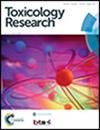发育神经毒性(DNT)QSAR 组合预测模型的建立和结构特征解释
IF 2.2
4区 医学
Q3 TOXICOLOGY
引用次数: 0
摘要
随着神经发育疾病发病率的上升,从大量环境化学物质中筛选和评估发育神经毒性(DNT)化合物并了解其作用机制已迫在眉睫。本研究首次基于哺乳动物的发育神经毒性数据开展了发育神经毒性定性结构-活性关系(QSAR)研究,并初步阐明了发育神经毒性化合物的结构特征。采用五种不同的分类算法和两种特征选择方法构建了预测模型。最佳模型对外部测试集具有良好的预测能力,但应用领域(AD)较小。通过组合三种不同的模型,MCC 和 AD 值都得到了改善。此外,通过建模描述符分析和结构警报(SAs)识别,还发现电子学性质、范德华体积相关性质和含有 S、Cl 或 P 的子结构与 DNT 相关。这项研究为进一步预测人类环境暴露中的 DNT 奠定了基础,并有助于理解 DNT 的机理。本文章由计算机程序翻译,如有差异,请以英文原文为准。
Developmental neurotoxicity (DNT) QSAR combination prediction model establishment and structural characteristics interpretation
With the incidence of neurodevelopmental disorders on the rise, it is imperative to screen and evaluate developmental neurotoxicity (DNT) compounds from a large number of environmental chemicals and understand their mechanisms. In this study, DNT qualitative structure-activity relationship (QSAR) study was carried out for the first time based on DNT data of mammals and structural characterization of DNT compounds was preliminarily illustrated. Five different classification algorithms and two feature selection methods were used to construct prediction models. The best model had good predictive ability on the external test set, but a small application domain (AD). Through combining of three different models, both MCC and AD values were improved. Furthermore, electronical properties, van der Waals volume-related properties and S, Cl or P containing substructure were found to be associated with DNT through modeling descriptors analysis and structure alerts (SAs) identification. This study lays a foundation for further DNT prediction of environmental exposures in human and contributes to the understanding of DNT mechanism.
求助全文
通过发布文献求助,成功后即可免费获取论文全文。
去求助
来源期刊

Toxicology Research
TOXICOLOGY-
CiteScore
3.60
自引率
0.00%
发文量
82
期刊介绍:
A multi-disciplinary journal covering the best research in both fundamental and applied aspects of toxicology
 求助内容:
求助内容: 应助结果提醒方式:
应助结果提醒方式:


